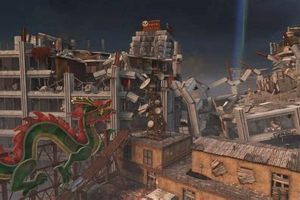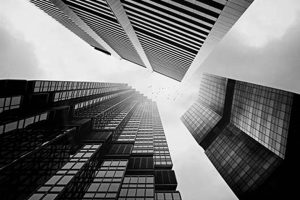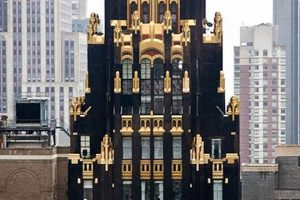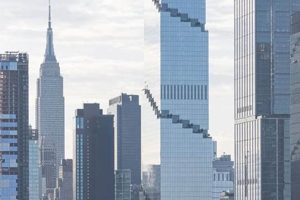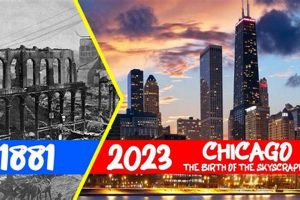Concept skyscrapers are architectural visions that push the boundaries of design and engineering. They are often characterized by their unique forms, innovative materials, and sustainable features. Unlike traditional skyscrapers, which are primarily designed for office or residential use, concept skyscrapers often serve as landmarks or cultural icons, embodying a city’s aspirations and technological prowess.
The importance of concept skyscrapers lies in their ability to inspire future developments and showcase the latest advancements in architecture and construction. They serve as a platform for experimentation and innovation, leading to new design solutions and sustainable practices. Historically, concept skyscrapers have played a significant role in shaping the skylines of major cities, becoming symbols of progress and urban development.
In this article, we will explore the fascinating world of concept skyscrapers, discussing their design principles, architectural features, and environmental impact. We will also delve into the history of concept skyscrapers, examining their evolution and influence on modern architecture.
1. Height
In the realm of concept skyscrapers, height plays a pivotal role in redefining the urban landscape. Towering structures pierce the heavens, becoming iconic landmarks that symbolize a city’s ambition and technological prowess. The pursuit of height in concept skyscrapers stems from several factors:
- Vertical Expansion: As cities become denser and land becomes scarce, architects turn to vertical expansion to accommodate growing populations and urban functions.
- Symbolic Significance: Tall buildings have historically been associated with power and prestige. Concept skyscrapers continue this tradition, embodying a city’s aspirations and dominance.
- Engineering Advancements: Innovations in structural engineering and construction materials have made it possible to build taller and more daring structures.
The height of concept skyscrapers not only defines their physical presence but also influences their design and functionality. Taller buildings require robust structural systems to withstand wind loads and seismic forces. They also necessitate advanced elevator systems and fire safety measures to ensure occupant safety and accessibility. Additionally, the height of a concept skyscraper can impact its environmental performance, as taller buildings may cast longer shadows and affect local wind patterns.
Real-life examples of concept skyscrapers that redefine the skyline include the Burj Khalifa in Dubai, the Shanghai Tower in China, and the One World Trade Center in New York City. These structures have become symbols of their respective cities and have pushed the boundaries of architectural design and engineering.
Understanding the significance of height in concept skyscrapers is crucial for architects and urban planners. It helps them design and construct structures that are not only visually striking but also structurally sound and environmentally conscious. As cities continue to grow and evolve, concept skyscrapers will undoubtedly play a vital role in shaping the urban skylines of the future.
2. Design
In the realm of concept skyscrapers, design takes center stage as architects push the boundaries of conventional architecture. Unconventional and futuristic forms challenge the status quo, creating visually striking and awe-inspiring structures that redefine the urban landscape. This emphasis on design stems from several key factors:
- Aesthetics and Identity: Concept skyscrapers often serve as landmarks and cultural icons, representing a city’s aspirations and unique identity. Their unconventional forms create a sense of wonder and excitement, attracting visitors and enhancing the city’s aesthetic appeal.
- Innovation and Experimentation: Concept skyscrapers provide a platform for architectural innovation and experimentation. Architects use these projects to explore new design concepts, materials, and construction techniques, pushing the limits of what is possible.
- Functionality and Sustainability: While aesthetics are important, concept skyscrapers also prioritize functionality and sustainability. Their unconventional forms can optimize natural light, reduce wind resistance, and incorporate sustainable features, making them not only visually appealing but also environmentally conscious.
Real-life examples of concept skyscrapers that challenge architectural norms include the Burj Al Arab in Dubai, with its distinctive sail-shaped profile, and the CCTV Headquarters in Beijing, known for its unique and functional form. These structures showcase the power of unconventional design to create iconic landmarks that redefine the skyline and become symbols of urban progress.
Understanding the importance of design in concept skyscrapers is crucial for architects and urban planners. It enables them to create structures that are not only visually stunning but also functional and sustainable. As cities continue to evolve and compete for global recognition, concept skyscrapers will undoubtedly play a vital role in shaping the architectural landscape of the future.
3. Materials
In the realm of concept skyscrapers, materials play a pivotal role in realizing the ambitious designs and achieving the desired performance. Advanced and sustainable materials enhance the durability, efficiency, and overall impact of these architectural marvels.
- Structural Strength and Innovation: Concept skyscrapers require robust materials to withstand the immense weight and external forces acting upon them. Advanced materials such as high-strength steel, composite materials, and fiber-reinforced concrete enable architects to push the boundaries of structural design, creating taller and more daring structures.
- Energy Efficiency and Sustainability: Concept skyscrapers prioritize energy efficiency and sustainability. Advanced glazing systems with low thermal conductivity and self-cleaning properties reduce energy consumption and enhance occupant comfort. Renewable energy sources, such as solar panels and wind turbines, are often integrated into the design, making these buildings more environmentally friendly.
- Durability and Longevity: Concept skyscrapers are designed to stand the test of time, enduring the elements and maintaining their structural integrity. Advanced materials resist corrosion, weathering, and seismic forces, ensuring the longevity of these iconic structures.
- Aesthetics and Visual Impact: Materials play a crucial role in the aesthetics of co
ncept skyscrapers. Architects use innovative materials and finishes to create visually striking facades that reflect the building’s unique identity and enhance the urban landscape.
Real-life examples of concept skyscrapers that showcase advanced and sustainable materials include the Burj Khalifa in Dubai, which utilizes a high-performance concrete mix and a cladding system designed to withstand extreme temperatures. Another notable example is the Shanghai Tower in China, featuring a double-skin facade with energy-efficient glazing and an integrated rainwater harvesting system.
The choice of materials in concept skyscrapers has a profound impact on their structural integrity, environmental performance, and overall aesthetics. By embracing advanced and sustainable materials, architects can create concept skyscrapers that are not only visually stunning but also durable, efficient, and environmentally conscious.
4. Sustainability
In the realm of concept skyscrapers, sustainability is not merely an afterthought but an integral part of the design process. Architects recognize the significant environmental impact of these towering structures and strive to minimize their ecological footprint through environmentally conscious designs.
The pursuit of sustainability in concept skyscrapers stems from several key factors:
- Environmental Responsibility: Architects have a responsibility to design buildings that respect and preserve the environment. Concept skyscrapers, with their immense scale and potential impact, demand a heightened focus on sustainability.
- Resource Conservation: Sustainable designs optimize resource utilization, reducing energy consumption, water usage, and waste generation throughout the building’s lifecycle.
- Tenant Well-being: Environmentally conscious designs promote occupant well-being by providing healthy indoor environments with ample natural light, fresh air, and thermal comfort.
- Long-term Investment: Sustainable practices can reduce operating costs and increase the building’s value in the long run, making it a wise investment for developers and owners.
Real-life examples of sustainable concept skyscrapers include the Burj Khalifa in Dubai, which holds the LEED Platinum certification and features advanced energy-efficient systems, and the One World Trade Center in New York City, which incorporates sustainable design elements such as rainwater harvesting and a green roof.
The integration of sustainability in concept skyscrapers has a profound impact on the environment and the well-being of occupants. By embracing sustainable practices, architects can create concept skyscrapers that are not only visually stunning but also environmentally responsible and healthy places to live and work.
5. Functionality
In the realm of concept skyscrapers, functionality takes center stage as architects strive to create structures that not only soar high but also serve a multitude of purposes, catering to the diverse needs of urban dwellers.
- Mixed-use Developments: Concept skyscrapers often incorporate a mix of residential, commercial, retail, and public spaces, creating vertical communities that offer convenience, accessibility, and a vibrant urban experience. For example, the Burj Khalifa in Dubai houses luxury apartments, offices, a hotel, and a shopping mall, all within a single iconic structure.
- Vertical Transportation Hubs: Some concept skyscrapers are designed to integrate transportation hubs, seamlessly connecting residents and visitors to various modes of public transport. The Shanghai Tower in China, for instance, features a high-speed rail station and a metro line within its base, providing easy access to the city’s transportation network.
- Community Amenities: Concept skyscrapers often include amenities such as fitness centers, swimming pools, and rooftop gardens, promoting a healthy and active lifestyle for occupants. The One World Trade Center in New York City boasts a state-of-the-art fitness center, a rooftop terrace with panoramic views, and a performing arts center.
- Cultural and Social Spaces: Some concept skyscrapers incorporate cultural and social spaces, such as art galleries, museums, or performance venues, contributing to the city’s cultural vibrancy. The Lotte World Tower in Seoul, South Korea, features an indoor theme park, a cinema, and a concert hall, making it a popular destination for entertainment and leisure.
By integrating diverse functionalities within a single structure, concept skyscrapers maximize space utilization, enhance urban connectivity, and create vibrant communities that cater to the evolving needs of modern cities.
6. Technology
In the realm of concept skyscrapers, technology plays a pivotal role in optimizing building performance, enhancing occupant well-being, and shaping the future of urban living.
- Smart Building Systems: Concept skyscrapers integrate smart building systems that automate and optimize building operations. These systems monitor and control lighting, HVAC, security, and energy consumption, leading to increased efficiency, reduced costs, and enhanced occupant comfort.
- Vertical Transportation: Advanced elevator systems and vertical transportation solutions are crucial for efficient movement within concept skyscrapers. They reduce wait times, optimize traffic flow, and provide seamless connectivity between different floors and zones.
- Indoor Environmental Quality: Concept skyscrapers prioritize indoor environmental quality by incorporating advanced air filtration systems, natural ventilation strategies, and real-time monitoring of air quality. These measures ensure a healthy and comfortable living and working environment for occupants.
- Building Safety and Security: Integrated security systems, advanced fire detection and suppression technologies, and robust structural designs enhance the safety and security of concept skyscrapers. These measures protect occupants, mitigate risks, and ensure peace of mind.
The integration of cutting-edge technologies in concept skyscrapers transforms these structures into intelligent and responsive environments that cater to the evolving needs of occupants. By embracing technological advancements, architects and engineers can create concept skyscrapers that are not only visually striking but also highly efficient, sustainable, and occupant-centric.
7. Landmark
In the realm of concept skyscrapers, becoming a landmark is not merely a byproduct of their towering heights and striking designs but a carefully orchestrated goal. Concept skyscrapers are conceived as iconic structures that transcend their function and embody the aspirations, cultural heritage, and unique identity of the cities they inhabit.
The significance
of a concept skyscraper as a landmark lies in its ability to define a city’s skyline, attract global recognition, and instill a sense of pride among its residents. These structures become symbols of urban progress, innovation, and architectural prowess. They serve as destinations for tourists and locals alike, offering breathtaking views and immersive experiences that showcase the city’s architectural achievements.
Real-life examples abound, with iconic concept skyscrapers such as the Burj Khalifa in Dubai, the Shanghai Tower in China, and the One World Trade Center in New York City becoming synonymous with their respective cities. These structures have transformed their urban landscapes, attracting millions of visitors and solidifying their status as global landmarks.
Understanding the importance of a concept skyscraper as a landmark is crucial for architects, urban planners, and city officials. It guides the design process, ensuring that these structures not only meet functional requirements but also contribute to the city’s cultural identity and global reputation. By embracing the role of concept skyscrapers as landmarks, cities can create structures that are not only visually stunning but also deeply rooted in the fabric of urban life.
8. Inspiration
In the realm of concept skyscrapers, inspiration serves as the genesis of architectural marvels that redefine skylines and shape the built environment. Concept skyscrapers are not merely tall structures but visionary expressions that challenge conventional design norms and push the boundaries of architectural possibilities.
The significance of inspiration in concept skyscrapers lies in its ability to ignite creativity and innovation. Architectural visions serve as catalysts for experimentation, encouraging architects to explore novel design approaches, materials, and technologies. These visions often stem from a deep understanding of urban needs, cultural context, and environmental concerns, resulting in structures that are both aesthetically captivating and functionally responsive.
Real-life examples of concept skyscrapers that embody inspiration include the Burj Khalifa in Dubai, inspired by the desert flower Hymenocallis, and the Shanghai Tower in China, designed to resemble a traditional Chinese pagoda. These structures have become iconic landmarks, inspiring countless future developments and shaping the architectural landscape of their respective cities.
Understanding the role of inspiration in concept skyscrapers is crucial for architects and urban planners. It emphasizes the importance of fostering a creative environment where bold ideas can flourish. By embracing inspiration, architects can create concept skyscrapers that transcend their structural purpose and become symbols of architectural ingenuity and urban progress.
FAQs on Concept Skyscrapers
This section addresses frequently asked questions about concept skyscrapers, providing concise and informative answers to common concerns or misconceptions.
Question 1: What are the key characteristics of concept skyscrapers?
Concept skyscrapers are architectural marvels that push the boundaries of design, engineering, and sustainability. They are often characterized by their exceptional height, unconventional forms, innovative materials, and integrated technologies.
Question 2: What is the purpose of concept skyscrapers?
Concept skyscrapers serve multiple purposes. They can be used for residential, commercial, retail, and cultural activities. Some concept skyscrapers are designed as mixed-use developments, offering a diverse range of functions within a single structure.
Question 3: How do concept skyscrapers contribute to urban development?
Concept skyscrapers play a significant role in urban development by providing innovative solutions to the challenges of population growth and land scarcity. They also serve as landmarks and cultural icons, enhancing the identity and global recognition of cities.
Question 4: Are concept skyscrapers sustainable?
Sustainability is a key consideration in the design of concept skyscrapers. Many incorporate advanced materials, energy-efficient systems, and renewable energy sources to minimize their environmental impact and promote occupant well-being.
Question 5: How do concept skyscrapers ensure safety and security?
Concept skyscrapers prioritize safety and security through robust structural designs, advanced fire detection and suppression systems, and integrated security measures. They are engineered to withstand extreme weather conditions and seismic activity.
Question 6: What is the future of concept skyscrapers?
The future of concept skyscrapers is promising, with ongoing advancements in technology, materials science, and architectural innovation. We can expect to see even more daring and sustainable designs that redefine the urban landscape and enhance the quality of life in cities.
In conclusion, concept skyscrapers are architectural marvels that showcase the ingenuity and creativity of architects and engineers. They contribute to urban development, sustainability, and cultural identity, and their future holds exciting possibilities for innovation and progress.
Transition to the next article section: Understanding the Significance of Concept Skyscrapers
Tips on Concept Skyscrapers
Concept skyscrapers represent the pinnacle of architectural innovation and engineering prowess. To create these awe-inspiring structures, architects and engineers employ a range of cutting-edge techniques and design principles.
Tip 1: Embrace Height for Impact and IdentityUtilize height to create iconic landmarks that define a city’s skyline. Consider the symbolic significance of height, associating it with power and ambition. Leverage engineering advancements to push the boundaries of structural integrity.Tip 2: Explore Unconventional Forms for Visual Appeal Challenge conventional architectural norms with unique and daring shapes. Experiment with organic forms inspired by nature or futuristic designs. Use unconventional forms to optimize natural light, reduce wind resistance, and enhance sustainability.Tip 3: Utilize Advanced Materials for Strength and EfficiencyEmploy high-strength steel, composite materials, and fiber-reinforced concrete for structural stability. Integrate energy-efficient glazing systems to reduce energy consumption and enhance occupant comfort. Use renewable energy sources, such as solar panels and wind turbines, for sustainability.Tip 4: Prioritize Sustainability for Environmental Responsibility Design energy-efficient systems to minimize environmental impact. Incorporate water-saving fixtures and rainwater harvesting systems. Use sustainable materials and construction practices to reduce waste and pollution.Tip 5: Integrate Smart Technologies for Enhanced FunctionalityImplement building automation systems to optimize building operations and energy consumption. Utilize advanced elevator systems for efficient vertical transportation.* Integrate sensors and IoT devices to monitor indoor environmental quality and security.Summary:By following these tips, architects and engineers can create concept skyscrapers that are not only visually stunning but also structurally sound, sustainable, and technologically advanced. These structures serve as testaments to h
uman ingenuity and innovation, shaping the skylines of cities around the world.
Transition to the article’s conclusion: Concept skyscrapers continue to push the boundaries of architectural design and engineering, inspiring future developments and shaping the built environment.
Concept Skyscrapers
Concept skyscrapers, with their towering heights, unconventional forms, and innovative designs, have transformed the architectural landscape and redefined the skylines of cities around the world. They represent a convergence of architectural vision, engineering prowess, and sustainable practices.
As we look to the future, concept skyscrapers will undoubtedly continue to push the boundaries of design and innovation. They will serve as testbeds for new technologies, materials, and construction techniques, shaping the built environment and enhancing the quality of urban life. By embracing sustainability, integrating smart technologies, and prioritizing functionality, concept skyscrapers will continue to be symbols of progress and architectural excellence.


